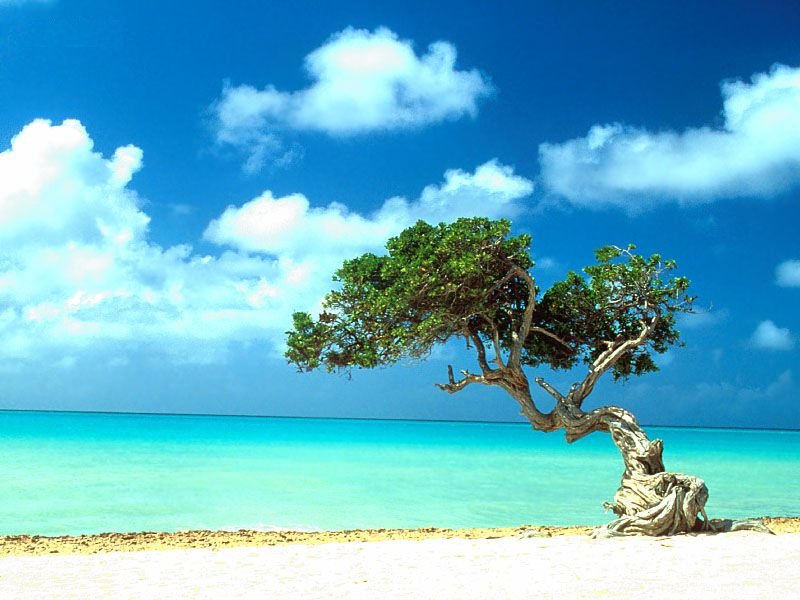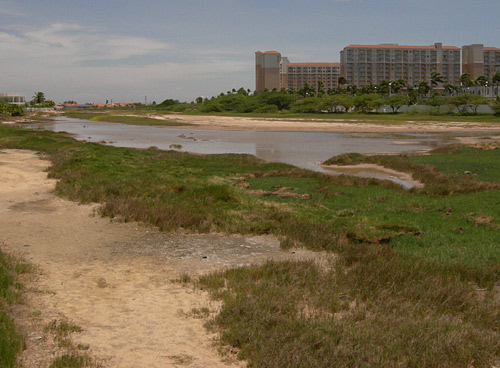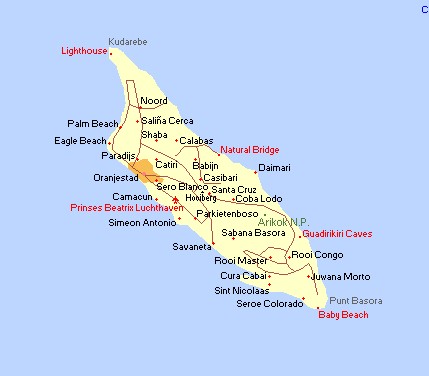
 Dragonflies & Damselflies of Aruba Theo Muusse - the Netherlands
Dragonflies & Damselflies of Aruba Theo Muusse - the Netherlands
Observations & Places visited by Theo Muusse in 2007.
  Dragonflies & Damselflies of Aruba Theo Muusse - the Netherlands Dragonflies & Damselflies of Aruba Theo Muusse - the Netherlands
Observations & Places visited by Theo Muusse in 2007. |
 Spot 1: The North-Eastern Ponds (GPS 12,35,18 70,01,21)
Spot 1: The North-Eastern Ponds (GPS 12,35,18 70,01,21)On Noord-Aruba, there are 3 small ponds and one larger pond at the un-inhabited eastern side. Two are situated near Ceroe Tres Cabes and Ceroe Grandi, the other 2 east of the large golf course. They do have a very small amount of floating water vegetation but do not have vegetaion along it. The water looks to be a little bit salty (brackish).
Visited 18-07-2007, twice; 20-07-2007, 25-07-2007.
Species seen:
Orthemis ‘arubensis’ 9 males (note 1)
Brachymesia furcata 12 males, once an ovipositing female
Ischnura ramburii 12 males + copula and ovipositing seen
 There is a sewage pond along the road leading east from St Ana RC to Calbas (road nr 3A). The pond is found 100 mtr from the church on the right hand side of the road. Its the lowest part of that area resulting in the water remaining at level during the drier periods. It contains sweet water (both sewage and rain) with a lot of floating vegetation. There are no reedbeds present. Visited: 21-07-2007, twice: 22-07-2007, 24-07-2007, 29-07-2007, 01-08-2007, 03-08-2007 and 07-08-2007.
There is a sewage pond along the road leading east from St Ana RC to Calbas (road nr 3A). The pond is found 100 mtr from the church on the right hand side of the road. Its the lowest part of that area resulting in the water remaining at level during the drier periods. It contains sweet water (both sewage and rain) with a lot of floating vegetation. There are no reedbeds present. Visited: 21-07-2007, twice: 22-07-2007, 24-07-2007, 29-07-2007, 01-08-2007, 03-08-2007 and 07-08-2007.
Species seen:
Orthemis ‘arubensis’ 8 males
Brachymesia furcata 15 males + ovipositing seen (4 times)
Brachymesia herbida 6 males
Tramea onusta 4 males, copula and ovipositing seen (note 2)
Ischnura ramburii 60; copula, ovipositing seen, also fresh males and females
Pantala flavescens 4 males and 1 female (03-08-2007)
Pantala hymenaea 2 males (03-08-2007)
Aeshnid spec .. 1 (note 3)
 The large freshwater lakes of the Bubali Bird Sanctuary are very important for large numbers of dragonflies (and birds) with an entrance near the Dutch windmill. It consists of filtered water used by the hotels for showering etc. Huge reedbeds are found around the open water. Near the Butterfly Farm and at the southern site (with less wind) there are some good very good spots. Visited 16-07-2007, 19-07-2007, 24-07-2007, 30-07-2007, 08-08-2007 and 11-08-2007.
The large freshwater lakes of the Bubali Bird Sanctuary are very important for large numbers of dragonflies (and birds) with an entrance near the Dutch windmill. It consists of filtered water used by the hotels for showering etc. Huge reedbeds are found around the open water. Near the Butterfly Farm and at the southern site (with less wind) there are some good very good spots. Visited 16-07-2007, 19-07-2007, 24-07-2007, 30-07-2007, 08-08-2007 and 11-08-2007.
 Species seen:
Species seen:
Orthemis ‘arubensis’ 14 males, 3 fresh males and 3 females
Brachymesia furcata 15 males, 3 females
Brachymesia herbida 30+ males
Ischnura ramburii 140+ ; copula, ovipositing, also fresh males and females
Erythemis vesiculosa 1 female (note 4)
Pantala flavescens 2 males and 2 females (apart)
On August 11 2007 no less than 14 P flavescens were seen.
This is the only inland bay of the island. The bay ends at the Frenchmen’s Pass, the north-eastern side of the bay. Mangroves in salt water is the order of the day here. Visited on 21-07-2007 and 29-07-2007.
Species seen:
Brachymesia furcata 1 young male, uncertain (note 5)
Erythrodiplax berenice 100+
29-07-2007:
Erythrodiplax berenice 200 ; also blue-gray males seen now
Orthemis ‘arubensis’ 1 male
A large very dark female ovipositing.. (note 5b)
Brachymesia furcata 2 males (away from the water)
In the nice “garden” many trees can be found as well as large stones /huge rocks. I could not find any water available to dragonflies but maybe there is. Visited 25-07-2007.
Species seen:
Brachymesia furcata 2 females
Tramea onusta 1 male (note 6)
Orthemis ‘arubensis’ 1 female
A pond near the road next to a little shop at the eastern side of the road.
This road leads to the fallen Natural Bridge.
Floating vegetation is present in this small pool, again without any vegetation surrounding it. It also consist of sweet water brought in by the rain. Visited 25-07-2007.
Species seen:
Brachymesia furcata 2 males, 1 guarded ovipositing female
Ischnura ramburii 2 males, 1 old female, 1 very fresh male (note 7)
Tramea onusta 1 male
Orthemis ‘arubensis’ 1 male
De Fontein
A well forming a stream through a private garden and creating 20 cm deep pools and ponds with loads of low vegetation around. There is hardly any floating vegetation. The water is very clear. In this wet green area surrounded by semi-desert, there is a large number of dragonflies and butterflies present. Nearby is the Boca Prins Plantage, a Rooi often containing water. This is also a good spot. Visited 28-07-2007 and 01-08-2007.
Species seen:
Erythemis vesiculosa 4 males, 1 female
Orthemis ‘arubensis’ 40 males, 3 females ovipositing guarded
Ischnura ramburii 100 males, 6 females, 2 copula
Brachymesia herbida 1 male
Ceroe Cadushi (12,28,02 69,53,31)
There are at least 2 ponds along the road near Ceroe Cadushi, near the SE-gate of Arikok NP. Floating vegetation is present in this small pool, again without any vegetation surrounding it. It also consist of sweet water brought in by the rain. On August 1st, the water level had already decreased quickly due to the big thirst of the wild donkeys and goats coming in to drink. The water is also used by humans for irrigation. Visited 28-07-2007 and 01-08-2007.
Species seen:
Orthemis ‘arubensis’ 12 male, 2 guarded females ovipositing
Brachymesia furcata 20 males, 2 copula, 2 ovipositing females (guarded)
Brachymesia herbida 1 male with ovipositing female
Tramea calverti 4 males
Erythemis vesiculosa 1 male
Ischnura ramburii 5 males and 2 copula; 2nd visit none!
Pantala flavescens 1st visit 1 male; 2nd visit 3 males, 1 female
The Cunucu Arikok, on the border of the Arikok NP. No visits.
In the home garden where I stayed (at Seroe Pela road), many palm trees and flowering bushes can be found. Visited every day (16-07-2007 until 12-08-2007).
Species seen:
Brachymesia furcata 1 male (seen twice)
Orthemis ‘arubensis’ 1 male (seen twice), 1 female on 10 and 12th of August 2007.
Tramea onusta 1 male (03-08-2007)
Tramea calverti 2 females on 10-08-2007
Pantala flavescens 1 on 112-08-2007
Near the airport strip, with an offshore island at 200 meters consisting of mangroves (renaissance Island), we visited this nice beach to rest. Many visit (17-07-2007).
Species seen:
Sympetrum illotum (!?) (note 8)
Tramea onusta 1 female flying past
 Spot 12 Flood plains near the Marriot Hotel (12,34,52 70,02,30)
Spot 12 Flood plains near the Marriot Hotel (12,34,52 70,02,30)After the heavy rain on Juli 26 2007, these plains contained temporarily rain-water. It immediately attracted many waders, terns and dragonflies. Visited on 26-07-2007, 27-07-2007, 06-08-2007, 10-08-2007.
Species seen:
Tramea onusta 1 male
Orthemis ‘arubensis’ 1 male, 1 female
Tramea calverti 5 males and 3 females on 10-08-2007
During some city-trips we encountered gardens with flowering trees attracting butterflies and a single dragonfly. Also, a sewage stream is running through the village. Visited eg on 30-07-2007 and 10-08-2007.
Species seen:
Orthemis ‘arubensis’ 1 male caught by a Tropical Mockingbird
Tramea calverti 2 females on 10-08-2007
Ischnura ramburii 2 males at a dripping pipe with very little vegetation near the Harbour.
Inside this department of Noord, ther is a large lake consisting of sweet water. It has steep borders consisting of rocks and sand. At the northern side some trees can be found. Sadly this lake is being used by the Arubans as car and tire dump, resulting in an unfriendly and un-interesting place. Visited on 02-08-2007 and 03-08-2007.
Species seen:
Pantala hymenaea 1 female (note 8)
Brachymesia furcata 40 males, 2 females, ovipositing seen
Tramea onusta 1 male
Orthemis ‘arubensis’ 3 male
Ischnura ramburi 1 male
A mangroved island near the coast, west of the airport-strip. No visits made due to musquito’s overload.
Yet another pond in a department North of Oranjestad. This pond is also filled with rain and sewage water, kept in a rocky hole. Steep borders and floating vegetation also characterise this pond. Visited 03-08-2007.
Species seen:
Brachymesia furcata 4 males, 1 female, ovipositing seen
Tramea onusta 1 male
Orthemis ‘arubensis’ 3 males, 1 female
Ischnura ramburi 40 males, 3 females, ovipositing seen
Some bushes and trees near the favourite beach spot, needed for the important holiday rest in between sightings. Many visits but 05-08-2007 opened the score.
Species seen:
Brachymesia furcata 1 female (05-08-2007)
Orthemis arubensis 1 female (05-08-2007)
A lot of water, but an open area with a lot of wind, artificial borders and probably insect killing liquids put in the water. Not a lot of dragonflies to say the least. Probably they do not like water with foam on it. Quickly visited on 05-08-2007 and 06-08-2007.
Species seen:
Brachymesia furcata 1 male (totally out of place)
Sewage water has created some ponds on the rocky terrace present next to the Hospital, at the west side. Nice vegetation and even reeds found on the borders. A small area but interesting (also with Burrowing Owl, Solitary Sandpipers and American Redstart). Visited on 05-08-2007, 06-08-2007, 09-08-2007 and 10-08-2007.
 Species seen:
Species seen:
Ischnura ramburi 60 males, 4 young females
Orthemis arubensis 2 males
Pantala flavescens 2 males
The next day:
Pantala flavescens 17 (most of them males)
Pantala hymenaea 1 male (paler)
Erythemis vesiculosa 1 female
Brachymesia herbida 1 female
Brachymesia furcata 3 males
Orthemis arubensis 3 males, 1 female; copula seen
Ischnura ramburi 60 males, 7 females, copula seen
Tramea calverti 4 males and 3 females
Yet another pond in a department North of Oranjestad. This pond is also filled with rain and sewage water, kept in a rocky hole. Very steep borders and no vegetation present. Visited on 05-08-2007.
Species seen:
Brachymesia furcata 2 males
A dried out pond with a lot of green on the floor. No rocks create a more marshy atmosphere. Many trees around so no problems with the wind (but with the heat). Nice spot with many butterflies and flycatchers. 05-08-2007 and 07-08-2007 been there.
Species seen:
Tramea calverti 2 males
Pantala flavescens 3 males
Pantala hymenaea 2 (males)
Micrathyria didyma 1 male (note 10)
The next day:
Tramea calverti 1 male
Pantala flavescens 1
Brachymesia furcata 1 male
Ischnura ramburi 2 males
Spot 22 Baby Beach Mangrove bushes (12,24,49 69,52,42)
Lone smaller and bigger bushes of mangroves keep some libelulas out of the wind. Visited on 10-08-2007.
Species seen:
Tramea calverti 3 females
(note 1); difficult identification; for now called arubensis.
(note 2); onusta?
Appendages very long and curved upwards to the front (like a hook). Legs brownish yellow at the base, black on tarsus; thorax brownish, abdomen all shining dark red with small black spots on S8 and S9. Hamulus pointed downwards below thickened S2. Back of eyes blue-gray. In flight, the abdomen are hanging downwards. Obvious dark-red spots at the base of the hindwind, approximately 1 cm in length, with an obvious transparent spot halfway. Reddish brown veins obvious at bases of the forewing and hindwing. Face pale red, on some red.
(note 3); description: a very large and dark aeshnid seen once and sadly not for a long period. Appeared yellow spotted on a dark abdomen with a heavy thorax. Wings obviously brown-tinged.
(note 4); also photographed by Roselenn Croes (at Bubali?) on an earlier date.
(note 5); description: a vivid warm yellow to orange yellow colored Brachymesia furcata- sized and shaped dragonfly. Thorax also orange-yellow. All wings obviously tinged yellow. Seen for a few minutes in between the mangroves of Frenchmen’s Pass. Lost out of sight due to the strong wind.
(note 5b); description: seen very shortly but a large dragonfly, appearing larger than Orthemis. Seen when ovipositing in the salt water in between the mangroves. Appeared blackish.
(note 6); description: no black visible on S8 and S9 (seen well); wing-patch looking obvious larger in comparison with the other Tramea seen here.
(note 7); the fresh male appeared all apple-green and transparant, seen at 6 pm.
(note 8); a small dragonfly with obvious red abdomen and an obvious yellow spot at the base of the wing was seen during a short 2 minutes. It was sitting on a branch at 30 cm above ground and could be observed from 3 metres. It immediately reminded me of a Sympetrum of the old world, with all red/ orange-red abdomen with small dark markings on S8 and S9, obvious yellow at both bases of the wing, orangy veins at the first half of the wing and paler spots at the sides of the thorax. The ptreostigma’s were reddish, the eyes red on top and browner below. The legs were pale.
This however leads to the unlikely identification of Sympetrum illotum, a new species to this area…
(note 9): description: size of P flavescens, obviously larger than surrounding Brachymesia.
Appearing darker than P flavescens, due to the darker abdomen and the dark band on the thorax. Hind-wings very broad with a very dark, small spot at the lower base of the hindwing.
This spot only visible when flying slower and coming real close. Pterostigma dark and not very small.
Abdomen orangy brown-yellow with obvious black markings at the upperside. Lower side of abdomen grayish. S1 and S2 thicker than S8 and S9, abdomen tapering. No very long appendages visible. Thorax grayish with a dark band across (looked like a black band in between two gray bands).
Eyes red-brown above, grayer below. Nose reddish.
Behaviour: only seen flying, erratic with unpredictable moves. Hunting in a small area next to a tree but now and then not avoiding the strong wind.
Difficult to follow through binoculars, making pictures being impossible.
After an hour it flew up a tree and dived down in it not to come out anymore. Seen between 5 and 6 pm.
Identification made with 90% certainty due to the lack of knowledge about look-alikes in the region.
On later data more were seen.
(note 10); a small dark dragonfly seen shortly. It was seen for 1 minute disturbed from a grassy terrain fling into a bush complex. Obvious were the white spots on S7 and the green eyes. Not many details seen but the grayish upperside of the thorax and S1/S2 were seen contrasting with the blackish S3-S6 and S8-S10. The side of the thorax also appeared dark.
From August 7 2007 onwards, the numbers of Pantala flavescens and Tramea calverti rose very quickly with flocks seen on different days and at different places for example;
on August 10 2007 at St Ana 8 males and 3 females of T calverti were seen (while the species was unrecorded for that spot up to that date).
Some other groups are described below:

At Bubali Bird Sanctuary, at the southern side, many dragonflies were seen on August 11 2007.
During a 200 meter walk the following numbers were noted:
Tramea calverti 70
Pantala flavescens 40
Tramea onusta 6
Pantala hymenaea 1
At the Hospital, on August 10 2007 the following was seen:
Tramea calverti 21
Pantala flavescens 18
Pantala hymenaea 2